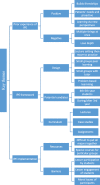A mixed methods approach to determine the climate of interprofessional education among medical and health sciences students
- PMID: 33836727
- PMCID: PMC8035734
- DOI: 10.1186/s12909-021-02645-4
A mixed methods approach to determine the climate of interprofessional education among medical and health sciences students
Abstract
Background: High-quality patient care is a complex phenomenon that requires collaboration among healthcare professionals. Research has shown that Interprofessional Education (IPE) carries promise to improve collaborative work and patient care. So far, collaboration among various health professionals remains a challenge. Very few focus group discussions to determine the medical students' readiness and positive attitudes towards IPE have been reported from the Arabian context.
Methods: A two-staged sequential mixed methods study was conducted among medical, dental, pharmacy, and health sciences students of the University of Sharjah United Arab Emirates. The perspectives of students toward IPE and collaborative practice were first gathered by administering a validated instrument, Readiness for Interprofessional Learning Scale (RIPLS). This was followed by focused group discussions. A quantitative as well as a qualitative data analysis was performed.
Results: This study cohort included 282 students. All respondents showed readiness to adopt IPE as all statements of the RIPLS inventory scored high median scores. All participants showed positive attitudes and readiness towards IPE. Three main domains of themes were generated from focus group discussions; prior knowledge, need for IPE framework and its implementation. Information workload, lack of clarity and less focused teaching pedagogies of IPE were considered as perceived barriers.
Conclusion: This study demonstrated a substantial agreement of medical and health sciences students towards readiness and perceived effectiveness of IPE. Educators are urged to embed new IPE programs into existing curricular frameworks, which can potentially enhance collaborative learning and improve quality of patient care.
Keywords: Focus groups; Gulf; IPE; Interprofessional education; Learning; Medical education; Middle east; Multiprofessional; RIPLS.
Conflict of interest statement
Not applicable.
Figures




References
-
- Goldman J. Centre for the Advancement of Interprofessional Education (CAIPE) website: www. caipe. org. uk. J Interprof Care. 2011;25(5):386–7.
-
- Guraya SY, Norman RI, Roff S. Exploring the climates of undergraduate professionalism in a Saudi and a UK medical school. Med Teach. 2016;38(6):630–2. - PubMed
-
- Reeves S, Goldman J, Oandasan I. Key factors in planning and implementing interprofessional education in health care settings. J Allied Health. 2007;36(4):231–235. - PubMed
MeSH terms
LinkOut - more resources
Full Text Sources
Other Literature Sources

